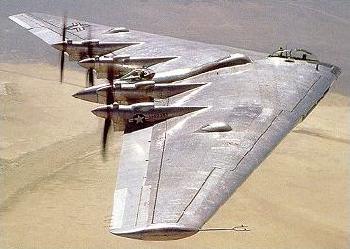
Jack Northrop (1895 - 1981)

Northrop XB-35 Jack (John Knudsen) Northrop by Peter Bergenson http://www.bergen.org/AAST/Projects/Engineering_Graphics/_EG2000/flyingwing/history/jack.htm JACK NORTHROP Born Newark NJ, Nov 10, 1895. Died 1981. John Knudsen Northrop's family moved to Santa Barbara CA in 1914, where he developed an deep interest in aeronautics in high school. In 1916 he had went to work for the Loughead Brothers as an engineering draftsman, contributing to the design of their twin-engine F-1 flying boat. Moving in 1916 to Douglas Co in Santa Monica, he went from draftsman to designer to project engineer om several early Douglas aircraft. The next major move came in 1927, when he went with Lockheed, there designing the original Vega. However, needing to develop his own ideas about all-metal airplanes, he struck off on his own in 1929 to form Northrop Aircraft Co, there producing the Alpha, an airplane that was regarded as well ahead of its time. Following the success of Alpha, he developed the all-metal design into Beta, Delta, and Gamma. Northrop Corporation was formed in 1932, and became a subsidiary of Douglas, to produce his designs of the USAC A-17 attack planes for and USN BT-1 dive bombers, as well as export models for foreign countries. In 1938 he sold his interests in the corporation to Douglas and formed Northrop Aircraft Inc, becoming its president and chief engineer until his retirement in 1952. There, in addition to many successful military aircraft, he developed his pet flying-wing project, the visionary concept of which, stalled by bureaucracy at the time, finally proved its value in our present stealth aircraft designs. Jack Northrop was a widely-known and well-respected name in aviation by that time, and he was awarded the Presidential Certificate of Merit for his "extraordinary contributions to the nation's defense in World War II." He presided over the Institute of Aeronautical Sciences in 1946, and became an honorary fellow in its successor organization, the American Institute of Aeronautics and Astronautics, and a fellow of the Royal Aeronautics Society. In 1947 he received the St Louis Medal from the American Society of Mechanical Engineers for "meretorious service in the advancement of aeronautics." Investiture in the International Aerospace Hall of Fame came in 1972 and in the Aviation Hall of Fame in 1974.
LinksBiographic
Jack Northrop Theory
Northrop: The Development of All-Wing Aircraft The Aircraft (in reverse order of development)
B-2A YB-49, 49A
YB-49 - Fifty Years Ago This Month XB-35
XB-35 XP-79B
XP-79BXP-56
XP-56 "Black Bullet" N9 Jack Northrop was the American genius behind the Flying Wing design. His theory was to make an entire aircraft the lifting body by eliminating the drag producing fuselage and tail group. Four Northrop N9Ms were manufactured during 1942-1945. They were the N9M-1, N9M-2, N9MA, and N9MB. They were constructed and flown to prove the Flying Wing concept as a sound design for the XB-35 and YB-49 Flying Wings. The first N9M flew in December 1942. Each model differed slightly in detail. The first three N9M models were powered by two 275 horsepower Menasco air-cooled, six cylinder, inline engines. These engines were procured from former unlimited air race planes at the Cleveland Air Races. The last model in the series, the N9MB, was powered by two specially built Franklin, eight cylinder, air-cooled, horizontally opposed engines of 300 horsepower. The N9MB was the only one to survive of the four models built. The Flying Wing piques everyoneís curiosity and was a wonderment to see flying in the air. After their testing career was over, the Wings were used to train Air Force pilots in Flying Wing transition. Because of the lessons learned in the smaller sixty-foot wingspan N9Ms, the giant XB-35 and YB-49 became awesome realities during the late 1940s. The Northrop Flying Wings were clearly ahead of their time!
Jack Northrops Jewel: N9M N-1M
N-1MJB-1
JB-1 "Bat"
The X Family THE X FAMILY -- Seven members of the famous X family of research aircraft once flown at the NACA High-Speed Flight Station (later renamed NASA Dryden Flight Research Center, Edwards, CA), are shown grouped on the Dryden ramp. They are, from top right, X-5, America's first variable sweep wing aircraft; D-558-I, first aircraft to fly twice the speed of sound; the semi-tailless X-4; the X-1A, a follow-on version of the original X-1; the jet powered D-558-I; and the XF-92A, first delta-wing aircraft. In the center is the X-3 jet-powered research aircraft. These aircraft in a joint research effort by the National Aeronautics and Space Administration (formerly the National Advisory Committe for Aeronautics) and the military services, explored transonic to low-supersonic characteristics of full-scale aircraft in flight. These aircraft belong to the so-called "Round One" era of research planes (NASA Photo)
The X-Planes Data Site
Aeronautics - Image Gallery - NASA X-series Research Aircraft
Northrop X-4X-5
The X-5 in Flight over the Mojave Desert finally and though not Northrop, a temporary holding place for McDonnell Douglas, Lockheed Martin and Vought
McDonnell Douglas X-36 Tailless Fighter Agility Research Aircraft |
© Copyright 1999-2003 CTIE - All Rights Reserved - Caution |